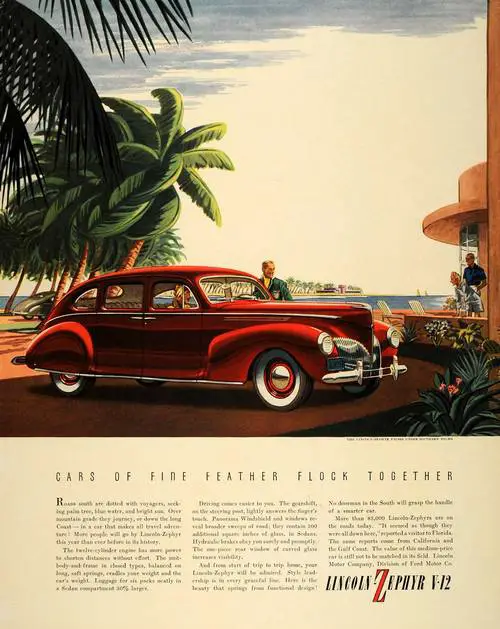Feature Story
HISTORICAL LINCOLN ZEPHYR '36 TO '48
by Bob Hagin
February 14, 1997
Unfortunately, 1996 slipped by without fanfare for the 60th anniversary of the '36 Lincoln Zephyr. This is surprising since the car justly deserves the title "The Car That Saved Lincoln." Without it, the Lincoln name might have sunk into oblivion.
In case you weren't around to experience them, the '30's were not good times. The end of the '20s ushered in The Great Depression and the car market took a nose dive, especially those brands on the big-ticket end of the spectrum. Lots of classy machinery bit the dust during that decade and now marques like Duesenberg, Pierce-Arrow, Marmon, du Pont and Peerless are only found in museums and automotive history books.
A couple of prestige makes hung on during those nightmare times and it was usually because they had a more economical model to sell along with their "carriage-trade" carriages. Cadillac relied on its clone, the La Salle Series 50, to see it through, while Packard brought out its middle-priced 110 and 120 models to keep it afloat.
For survival, Lincoln had its Zephyr V12 - but the Ford-owned company had a problem that the other two didn't have to face. The Ford Motor Company was literally an industrial kingdom and Henry Ford I was its Mad King. The history of the company and the Ford family would have made a fine plot for a Shakespearian tragedy.
Old Henry (as differentiated from his grandson, Henry II) was an autocrat and a tyrant. He seemed to take delight in tormenting and degrading his only son, Edsel, who was ostensibly the president of Ford Motor Company but was in reality the president in name only. Old Henry ran the show and with an iron hand. Edsel Ford's only automotive source of solace was in automotive design and operation of the captive Lincoln Motor Company which he considered his personal noblesse oblige. He was quoted as saying that his father had made the most popular car in the world - the Ford Model T - and he wanted to make "his" Lincoln the best.
Henry Ford bought the two-year-old Lincoln Motor Company early in 1922, supposedly to save the reputation and fortunes of Henry Leland, the aging and venerated engineer who started the company. Leland named the company after our 16th president and it was his intention to make Lincoln the American Rolls-Royce. But his firm quickly ran out of money. When the Lincoln deal was struck, Ford alluded to the fact that Leland and his son Wilfred would have a free hand in operating the company, but within six months, the pair were literally tossed out.
Without a doubt, the Lincoln was a high-quality car under the Lelands, but stodgy and unappealing. Edsel was given a relatively free reign in upgrading the car, and this he did by commissioning quality designs as production line models, as well as cataloging a dozen custom models built by some of the most famous coachbuilders in the world. The fortunes of Lincoln took off as the cars became bigger, faster and more prestigious. But The Depression hit in '29 and when 1932 rolled around, the picture was bleak. Edsel Ford was determined to keep Lincoln from becoming a casualty and went to the Briggs Body Company for rescue.
John Tjarrda, a young Dutch designer, was working for Briggs at the time and being an aeronautical engineer by training, was interested in applying aviation techniques to auto making. He had worked for Briggs during the time it helped developed the ill-fated Chrysler Airflow project and had a working knowledge of monocoque body construction and aerodynamics. He had a design on the boards for a rear-engined aerodynamic sedan that bore a striking resemblance to the "People's Car" being developed in Germany. Edsel fell upon it as a savior for Lincoln and authorized one to be built using a Ford V8 engine for the Chicago World's Fair of 1934 where it caused a sensation. Thus encouraged, he pressed on with plans for a production version to be marketed in 1936.
Needless to say, Old Henry had more than a little to say about the design and insisted that it be front-engined, stopped via mechanically- operated brakes, and carried on antiquated solid-axle suspension up front and a torque drive to the rear. In a flash of genius, Edsel directed Lincoln engineers to tack four more cylinders onto the existing Ford V8 engine, the result being a low-cost 12-cylinder engine to power his new Lincoln Zephyr. The name had been purloined from a popular streamlined passenger train of the day and sales soared. During 1he 1937 sales year, over 30,000 Zephyr coupes, sedans and convertibles were sold, while sales of its companion, the high-priced Model K, dropped to under 1000. The days of that luxurious behemoth were at an end and in 1940 only two were sold. Ironically, they were holdovers from the 1939 production run.
The Tjarrda Zephyr design became the only Lincoln model offered for sale and it was continually updated until the end of its production life in 1948. The Zephyr name was dropped after World War II but Ford used it again in 1978 on its mid-sized Mercury sedan, dropping it with when that company introduced its front-drive Topaz mid-sized car.
During the '30s, a dozen or more auto makes disappeared, victims of The Great Depression. Lincoln dealers can thank Edsel Ford and his spectacular Lincoln Zephyr for saving their brand from the same fate.



